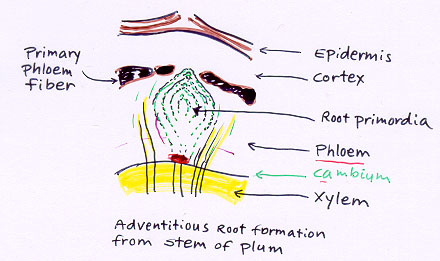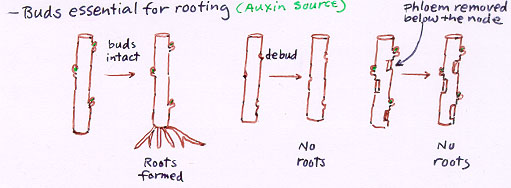PRINCIPLES OF PROPAGATION BY CUTTINGS
I. GENERAL INTRODUCION
- Kinds of
Cuttings
a. Stem
cuttings
b. Leaf-bud
cuttings (single-eye cuttings)
c. Root
cuttings
d. Leaf
cuttings
- Totiopotency
-The
ability of an individual cell to reconstitute the entire plant parts and
functions
-Each
cell has all the genetic information necessary for plant regeneration
- Dedifferentiation
-The
capability of previously developed, differentiated cells to return to a meristem
II. ADVENTITIOUS ROOT FORMATION
A. What is
Adventitious Root?
Roots
arising from any plant parts other than by the normal development of seedling
roots
Two
types:
From preformed roots (aerial roots)
Response to wounding (at cut stem base)
Root Formation After Wounding
1. A necrotic plate is formed at wounding site
-corky material (suberin) seals the wound
-gummy material plugs the xylem
-protection against desiccation and pathogens
2. Living cells behind the plate divide
Four Stages of de novo (anew) Adventitious Root Formation
1. Dedifferentiation
-by specifec differentiated cells
2. Formation of root initials
-dedifferentiated cells near vascular bundles become meristematic
3. Root primordia are formed
-from root initiating cells
4. Root emergence
-vascular tissues are formed and connected to the cutting
B. Root Formation
in Herbaceous Plants
-Adventious
roots originate just outside and between vascular bundles
The tissue from which roots originate varies
i.e. phloem parenchyma (mung bean, pumpkin)
epidermis (crassula)
pericyle (coleus)
C. Root Formation
in Woody Perennials
-Adventitious
roots originate from living parenchyma cells in young secondary phloem
Also from vascular rays, cambium, phloem, lenticels ro pith
Site of Adventitious Roots
III. CALLUS
-
Callus forms at the cut end
under
environmental conditions favorable for rooting
-
Callusing and adventitious rooting independent of each other in most species
-
In difficult to root species, adventitious roots may form from callus
i.e.
Pinus radiata, Sedum, Hedera helix
root formation of friable callus may be detrimental
(i.e. tissue culture rooting)
IV. LEAF CUTTINGS
A. Leaf Cuttings
with Primary Meristems
-Foliar
'embyos' (young plants) are resent of leaf margins or bases
-Leaf
cuttings made from leaves containing the latent primary meristems
-Plants:
Bryophyllum (Kalanchoe)
Tomiea (piggyback plant)*
Comptosorus (walking fern)
B. Leaf Cuttings
with Secondary Meristems
-New
plants are formed on secondary meristems
Secondary meristems arise from mature cells after wounding
-Both the roots and shoots are generated (the root from first before the shoots)
- Buds develop
from pericycle (between endodermis and phloem) near the vascular
cambium
- Adventitious
root formation often more difficult than the formation of adventitious buds
Adventitious roots form at the base of adventitious shoots on the root cutting
- Adventitious shoots arise more readily from roots of juvenile plant than from roots of mature plants
VI. POLARITY
- Shoots form
at the distal end (nearest the shoot tip)
Roots form at the proximal end (nearest the crown
- Reversal of the position of cuttings with respect to gravity does not alter the polarity
- Small pieces of stem tissues still exhibit polarity effect
VII. PLANT GROWTH SUBSTANCES
INVOLVED IN ADVENTITIOUS SHOOT AND ROOT INITIATION
Phytohormones- a group of organic compounds, other than nutrients, produced
by plants which, in
low concentrations, regulate physiological processes in growth and development
Plant Growth Regulators- phytohormones or synthetic compounds that modify
plant physiological process
A. Auxins
-Natural:
Indoleacetic Acid (IAA)
-Synthetic:
Indolebutyric Acid (IBA)
Naphthaleneacetic Acid (NAA)
-Enhances
root initiation, activates cambial cells, apical dominance
-Synergistic
to cytokinin, GA activities
-Concentration
Specific
B. Cytokinins
(promotes cell division)
-Natural:
Zeatin
-Synthetic:
Kinetin, Benzyl adenine (BAP)
-Enhances
shoot initiation and development
-Synergistic
to auxins
Low auxin and high cytokinin------------>adventitious buds
High auxin and low cytokinin------------->adventitious roots
C. Gibberellins
(GA)
-Promotes
cell elongation, division
-May
inhibit both adventitious bud and root formation
-Concentration
dependent
D. Abscisic
Acid (ABA)
-Regulates
stomatal activity, dormancy
-Antagonistic
to GA
-Effect
on root promotion not well understood
E. Ethylene
(C2H4)
-Involved
in fruit ripening, abscission, dormancy
-Promotes
rooting in intact plant parts
-Production
enhanced by auxin applied
VIII. Effects of Buds and Leaves
A. Presence
of buds on the cutting stimulates rooting
-buds
essectial for rooting (auxin source)
-removal of buds or a ring of bark below a bud results in no rooting
B. Presence
of leaves stimulatory to rooting
-Carbohydrates
translocated to root initiation site
-Auxin
source
-Cuttings
containing leaves root better
C. Rooting
Cofactors
-Synergistic
to auxins
-A group
of compounds (polyphenol oxidase, IAA oxidase, etc.) needed
for activation of root initiation
-Translocated
from leaves to rooting site
D. Endogenous
Root Inhibitors
-Present
more in hard-to-root plants
-Synthesized
in roots and moved upward into shoots
-Reduce
root quantity and quality
Found in pear, Vitis (grape), Eucalyptus
Leaching the inhibitors out of cut ends recovers rooting
IX. PLANT CLASSIFICATION IN RESPECT TO ROOTING ABILITY
- Three Classes:
1) Rapid
rooting - plants contain all necessary
substances required for rooting (cofactors, auxin, etc.)
- roots immediately under favorable environment
2) Auxin
requiring - plants contain all internal cofactors
but lack auxin
- root well when auxin is applies
3) Cofactor-deficient
- one or more cofactors lacking
- auxin application fails to stimulate rooting
X. FACTORS AFFECTING SUCCESS OF CUTTING
A. Environmental
Conditions
-moisture
-temperature
-light
intensity and duration
-O2
B. Physiological
Status
-stock
plant health and etiolation
-carbohydrates
-mineral
nutrition
-girdling
C. Type of
Wood Selected
1. Rooting
difference between lateral and terminal shoots
2. Proximal
vs. distal selections
3. Flowering
vs. vegetative woods
4. 'Heel'
vs. 'nonheel' cuttings i.e. quince, cuttings with
'heel' better
D. Seasonal Timing